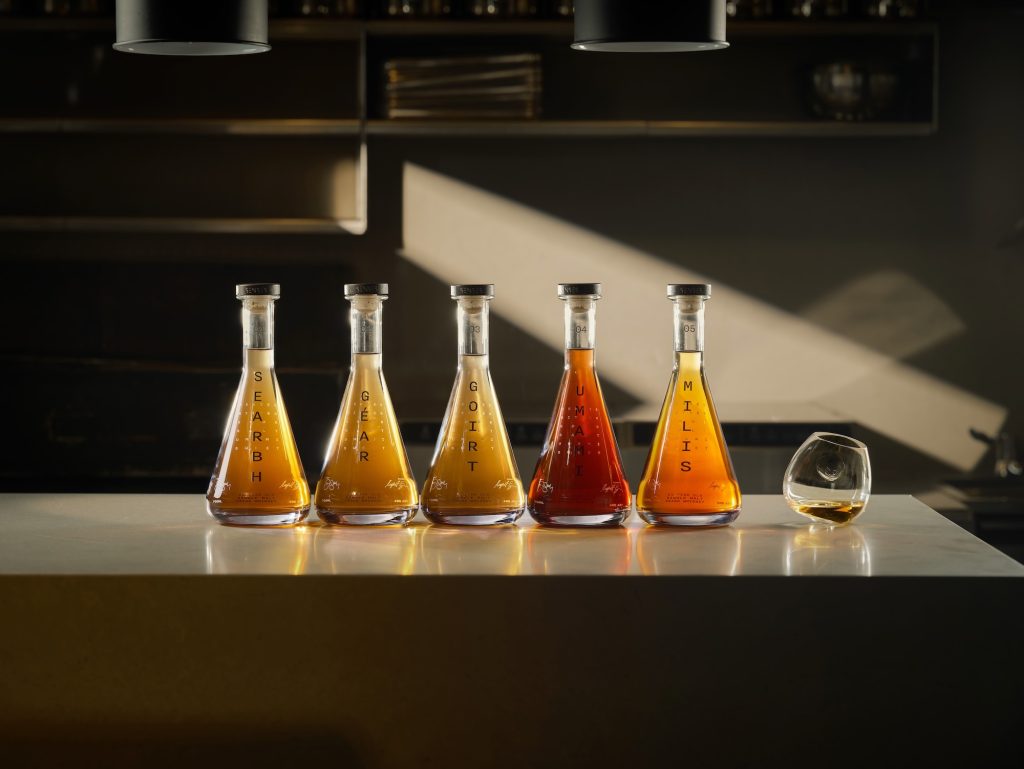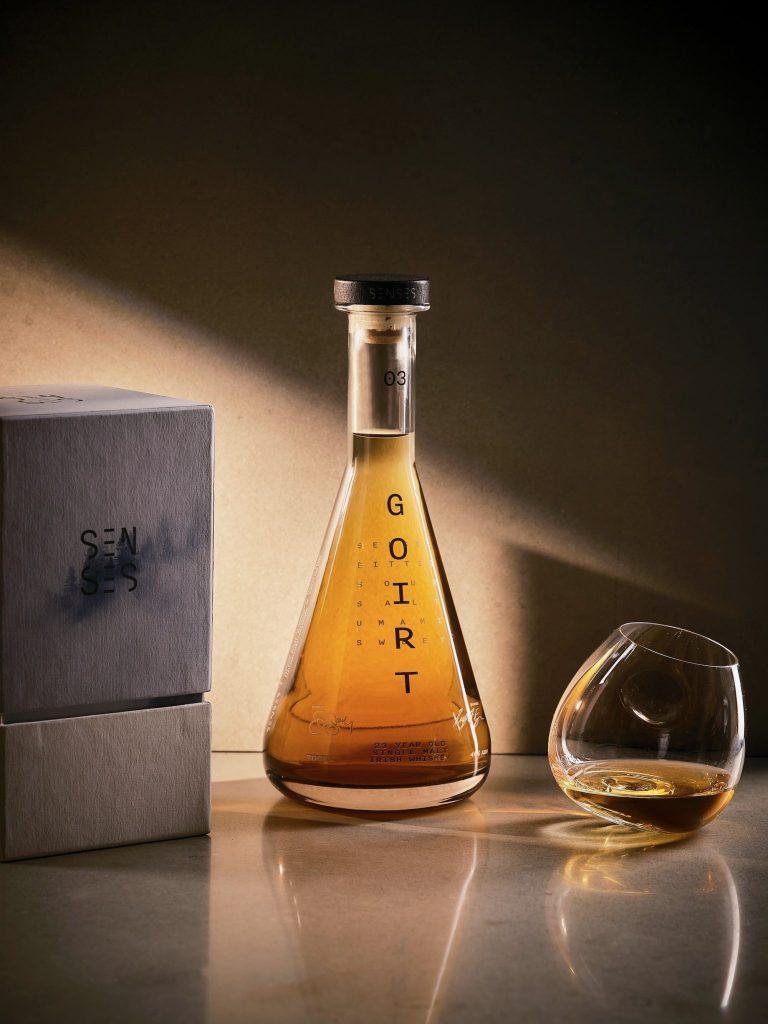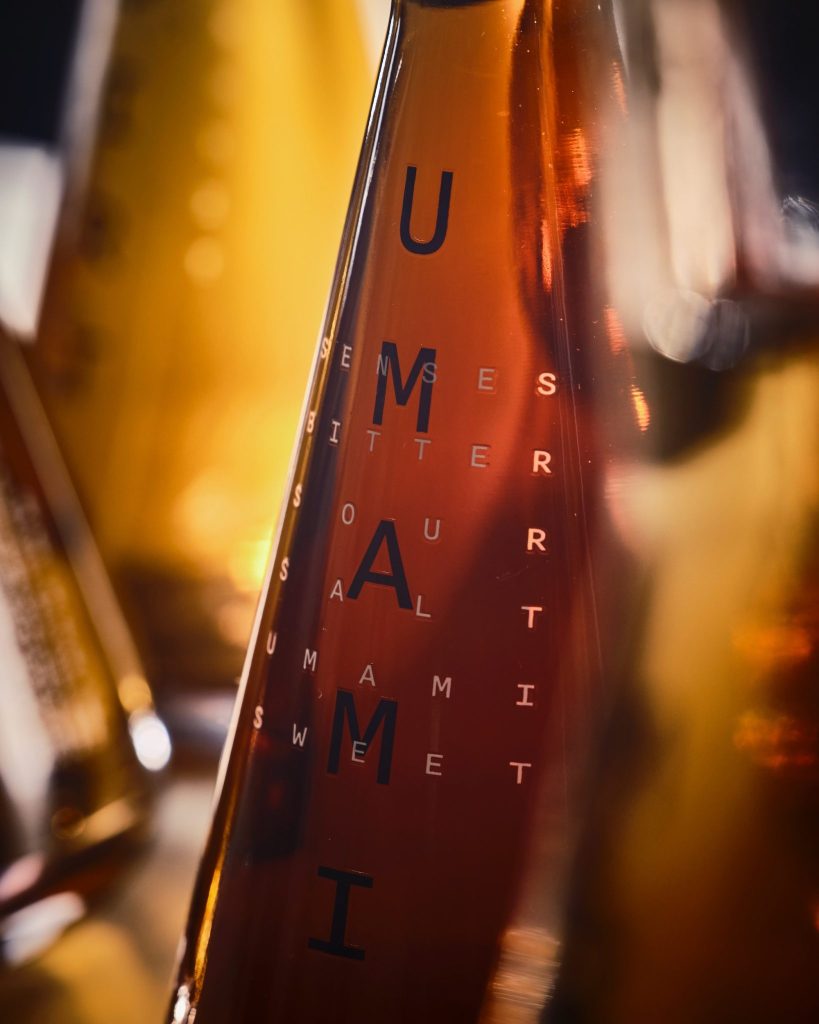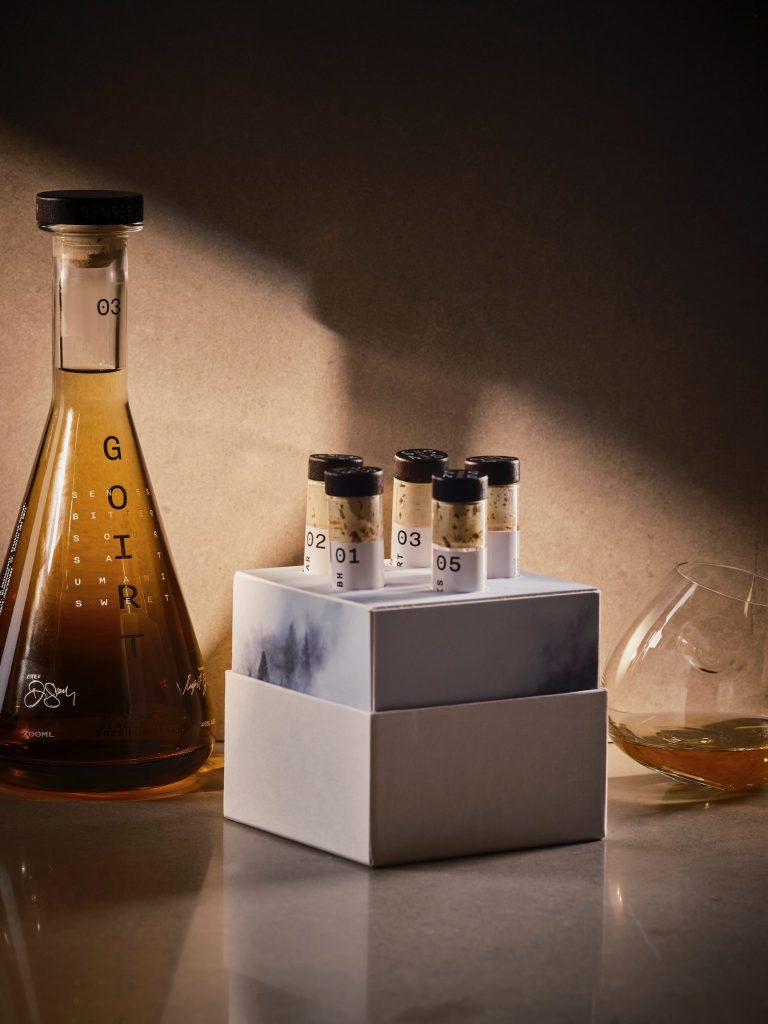In this ‘In Conversation with’ we meet Rupert Egan, Head Bonder of Egan’s Irish Whiskey, and Damien Grey, Head Chef and Owner of the Two Star Michelin restaurant Liath. This ‘spirited’ interview is an insight into their journey and unconventional collaboration for the groundbreaking project, ‘Senses’, a first in the world of Irish whiskey, Read on to discover more.
Let’s start at the beginning. How did you two meet?
Rupert: The first time I met Damien he was behind the pass at his then One Michelin Star Restaurant – Heron and Grey. After visiting Damien’s restaurant several times and witnessing the green shoots of him experimenting with whiskey as an ingredient, I felt acquainted enough to suggest that he might consider swapping household whiskey brands for something completely bespoke. And so, for about a year afterwards, I could be found trotting in and out of the Two Star Liath Restaurant, clinking with different distillates, ages, cask types, blends, finishes and serving strengths.
To say that Damien doesn’t march to the beat of another’s drum is an understatement; in fact, it seems he has discarded the drum as a percussive instrument entirely. For cooking, he sought whiskeys that would ordinarily have been deemed too young, too high in ABV, or too hot for an everyday palette. He was naturally drawn to the unusual, attracted by the magic of possibility.
How I didn’t see that I was being covertly interviewed by Damien is now utterly beyond me.
And that lightbulb moment – when/how did the idea for Senses came about?
Rupert: I have an inherent interest in working with unusual people who do unusual things, so when Damien said “let’s make a whiskey” there was no chance I’d decline. We both knew the journey was going to be anything but conventional and for me, as a whiskey bonder, this was the holy grail.
But where to start? We both agreed we wanted to strip it all back and do something foundational, fundamental, and disruptive. Damien was already asking questions around the building blocks of taste from a gastronomic perspective. He had been awarded a second Michelin Star with Liath Restaurant and had reshaped the tasting menu as a canvas-laboratory hybrid.
Then it hit us; take five casks of ultra-premium Irish whiskey and re-cask each to bring forward the five building blocks of taste – Bitter, Sour, Salt, Umami and Sweet. The rest is history.

The exclusive collection launched this month, but it has been a labour of love for several years. Please tell us more about the journey – the highs and the lows!
Damien: The low for anyone creative is not knowing, or second guessing how something will turn out or be perceived after you’ve put every fibre of yourself into it. The high, undoubtedly, was the first taste out of the barrel – the realisation that the experiment had worked, and then some.
Rupert: As the man in charge of logistics one low I distinctly remember was wading through the 17 different documents required to get a single ex-mezcal cask out of Mexico. It felt like every barrier was being put up and while also believing this was the only cask for the job – I was lower than a snake’s belly that night. One of the many highs has been seeing the bottle and packaging in the flesh after basing many design decisions off 3D renders and CGIs. They’ve had the exact impact we wanted.
Working alongside one person so intensely is a challenge in itself, what are your individual strengths and how did you maximise them through the process.
Rupert: We wanted to be honest with what we created and not simply reflect what the whiskey world typically delivers. We first tolerated but would soon embrace each other’s idiosyncrasies and, in doing so, have created something incredibly liberating and unique.
On one hand you’ve got Damien approaching this with a gastronomic mindset and an incredible knowledge of how certain foods and flavour profiles can unexpectedly deliver against the five building blocks of taste. And on the other, you have my expertise as a bonder and blender to come up with innovative solutions for cask finishing to marry up to where Damien’s head was going.
It’s been full of sliding doors moments to get to where are today, but I don’t believe there’s anyone else who would have come together in the way we have to deliver what we have.


This is a first in the world of Irish whiskey, born from a shared goal of expressing taste’s five building blocks – Bitter, Sour, Salt, Umami, and Sweet – the result is an extremely deep flavour profile. What can ‘drinkers’ expect?
Damien: Quite simply, the unknown. We have deliberately not created tasting notes because we want people to tell their own stories with the whiskeys – a dish, a memory, a visit to a specific restaurant or bar that it reminds them of. This is a different way of experiencing whiskey.
Rupert: When we see people taste these whiskeys with the description and an understanding of how they have come to pass, people kind of stop talking for a little bit. They just sort of nod, and they sort of tilt their head a little bit. They keep on nodding. They are definitely understanding something more about their own capabilities as tasters. Their reactions suggest they haven’t had that experience before.
Why did you choose an ultra-premium 23-year-old Single Malt Irish whiskeys for this collection?
Rupert: We wrote our mission statement in early 2023 and wanted to mark it so a 23-year-old whiskey as the basis felt like a good starting point. We tried lots of different types of Irish whiskeys; we tried grain blended whiskeys, pot stilled. double distilled, triple distilled. Some pot still whiskeys just aren’t going take on the flavour inputs from the finishing casks as we might have liked. Triple distilled can be a little fragile, and double distilled kind of fitted nicely in between those two worlds – it’s a bigger, meatier, chewier whiskey
You both literally, travelled the globe to find the most unique and suited cask partners for our whiskeys. Tell us more about this adventure, your selection criteria, and the chosen partners.
Rupert: Knocking on the door of other producers around the world to get the casks we needed was equally invigorating. There’s something special about describing the project to other like-minded people and seeing their eyes shine with excitement.
When starting with 23-year-old Single Malt whiskey, you need to be confident any next step must elevate what is already a spectacular spirit. The concept of using whiskey as a conduit for delivering each of the five individual characteristics of taste has simply never been done before, by anyone, anywhere. We knew we needed to tread carefully and would end up, quite literally, travelling the globe to find the most unique and suited cask partners for our whiskeys.
We’ve enlisted the expertise of some of the world’s finest wine and spirits producers for Senses, with some barrels taking 18 months to source and select and several cask partners not having collaborated with the whiskey world before.
We went to any length required to ensure the perfect cask finish, for example, to create our Search (bitter) whiskey I put a cask in the back of the car, drove it to Mayo and had it re-charred, filled it with a bespoke Imperial Stout by Dot Brew and filled the now ex-stout cask with the single malt whiskey, forming the most amazing dark-chocolate and coffee notes that gently gesture towards bitterness. For Goirt (salt), I’d stumbled across a price list from the records of my great grandfather’s spirit importation business which listed Godet, the world’s oldest Cognac, as one of his offerings – I wanted a wine or spirit that had been produced and aged by the sea, so we contacted Jean-Jacques Godet after a more than 100 year hiatus to both re-introduce the Egan family and secure his interest in our initiative, as well as one of his oldest ex-Grande Champagne casks. Arguably our most leftfield cask used for Senses was to create our Géar (sour) whiskey; we wanted citrus and mild smokey notes and looked towards a Mezcal cask. We were introduced to a distiller in Oaxaca with an almost mythical reputation for producing spirits that others won’t. Mezcal is the world of yesteryear that whiskey can now just about remember.


What’s the perfect serve for Senses?
Damien: Neat, room temperature, 50ml and three drops of ice-cold water after the first mouthful. And absolutely don’t listen to the long-held view that whiskey can’t work with food. I encourage you to have it with food – don’t underestimate what it will do with different flavour profiles. It’s a really enjoyable experience.
Damien, please tell us more about what diners at the experience at Liath Restaurant and your approach to presenting the five characteristics of taste?
Damien: Diners at Liath can expect precision, quality, fun, excitement, and a relaxed atmosphere without feeling intimidated. Dining at our restaurant is meant to be a special experience, an occasion rather than a necessity. We are grateful for every guest who chooses us for their special meal, and we aim to provide an exceptional experience.
The approach to the senses project started in 2017 and has been evolving ever since. Initially, we didn’t set out with the intention to create a dining experience of this kind, but we discovered a unique code of how to pair food and flavours and we’ve been on the journey ever since because we believe deeply in it. The key was unlocking how the senses interact with taste, which has transformed how I cook and compose dishes and tasting menus. It has been a remarkable journey.
Which dish did / do you most enjoy creating?
Damien: One dish that stands out is the Eel Cornet – it’s been on the menu since Liath opened. It’s simply called ‘Reggiano Parmigiano, truffle, and eel’. This dish has evolved from a simple parmesan churros with eel paste to a refined and specific combination of ingredients delivering a unique umami experience in a non-traditional way. It holds a childhood memory and represents the future of gastronomy, showcasing that smaller portions can have significant impact.
If you could liken the collection to a person, who would it be and why?
Damien: Salvador Dali. He embodies the extravagance, uniqueness, and mystery that the Senses collection represents. His work reflects the kind of dreams you have after indulging in it—surreal, unexpected, and profound. His cookbook is also off the charts, which aligns with the creativity we strive for.
Rupert: That’s a great answer. Salvador Dali perfectly captures the essence of unpredictability and creative excellence that we aim to convey with the Senses collection.
Luxury is highly subjective – what does it mean to you?
Damien: Luxury means a once-in-a-lifetime experience—something super unique and special that you probably won’t do again.
Rupert: It’s experiential. It’s not just about having the biggest wallet. The Senses collection, limited to only 200 sets, is exclusive and represents a once-in-a-lifetime opportunity. It’s about creating memorable and unique experiences.
Finally, what is your life motto? (if you have one)
Damien: if you go fast, you’ll go slow, and if you go slow, you’ll go fast – basically, if you rush, you’ll make a mistake and do it again, so take your time, do it properly and you’ll do it faster with more precision.
Rupert: For me, it’s “because of, not in spite of.” It’s the challenges that create great outcomes, not in spite of them but because of them. Difficulties bring out the best results.
Priced at €5,950, each Collector’s Case includes five 700ml bottles, a Sample Box with five 40ml tasting phials, and a series of beautifully produced cards documenting the three-year development journey. Only 200 sets are available globally, making ‘Senses’ a truly exclusive offering.
For more information and to purchase ‘Senses,’ visit Celtic Whiskey Shop.




